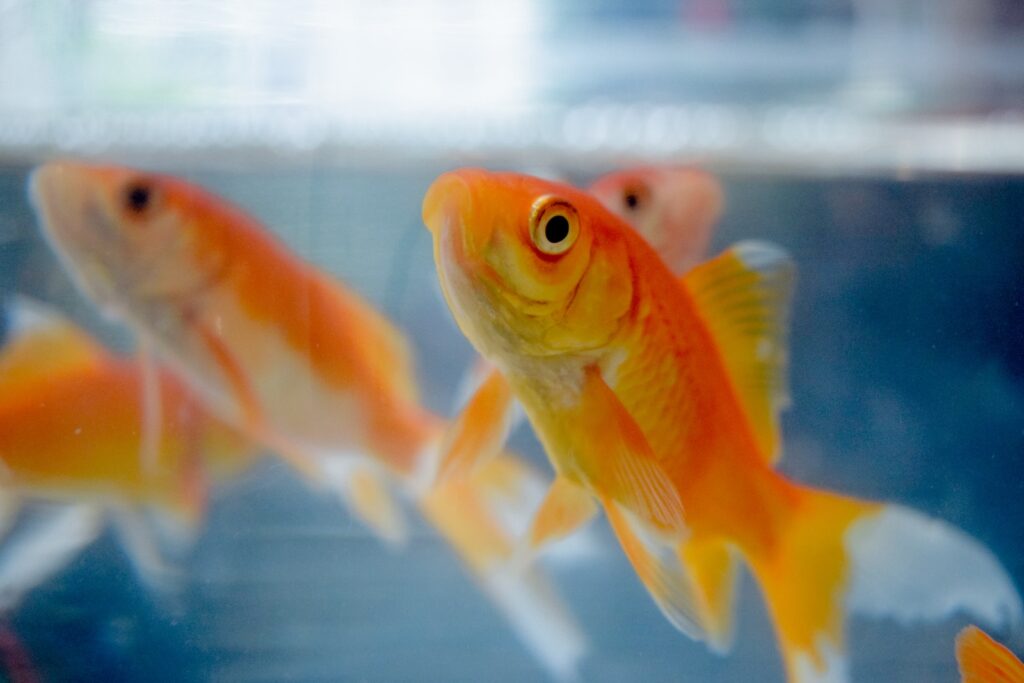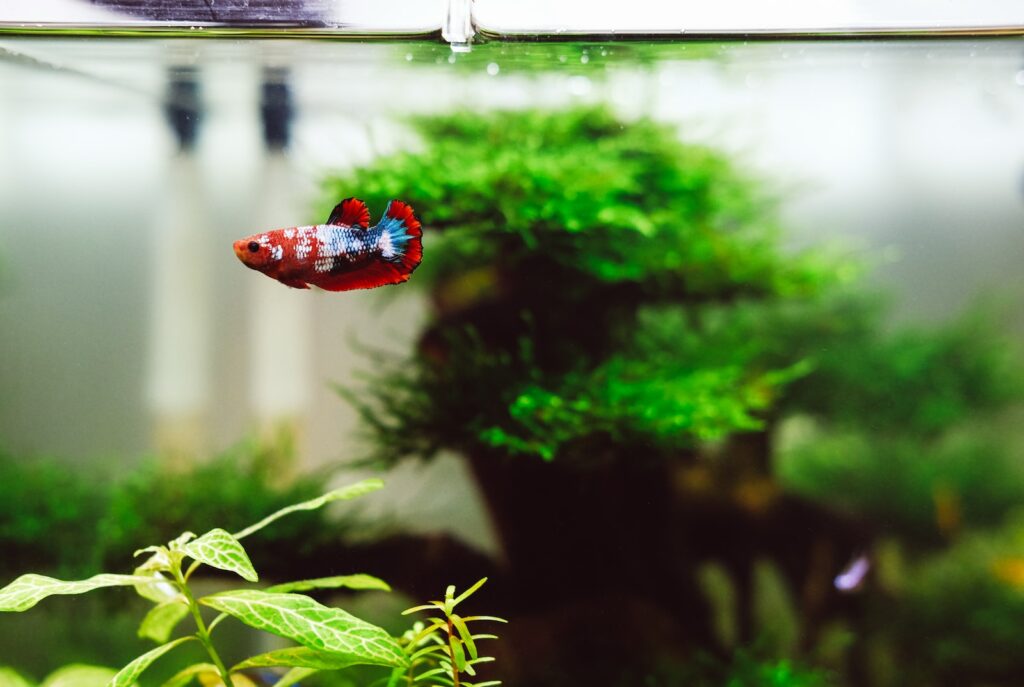Oh, the sheer tranquility of watching a goldfish gently glide through the water! It’s an experience that calms the soul, taking one back to simpler times. But, ever wondered if these gold beauties fancy some companionship in their aquatic realm? Well, let’s plunge into this wet and wondrous world!
Understanding Goldfish Nature
Before introducing any tank mate to your goldfish, it’s paramount to truly comprehend the behavior and requirements of these golden swimmers.
Goldfish Temperament
Goldfish, by nature, are pacifists. They meander gracefully through the waters, radiating serenity. However, they do have a quirky side; sometimes, they might innocuously nibble on the fins of other fishes. It’s not an act of aggression, just a touch of playful mischief they occasionally indulge in.
Goldfish Diet
When it comes to food, goldfish aren’t particularly fussy. Being omnivorous, they are happy to feast on a mix of plant matter and tiny aquatic creatures. This dietary habit is an essential aspect to remember when thinking about other potential aquarium inhabitants.
Goldfish Size
One might start as a tiny, golden speck, but given time and proper care, some goldfish varieties can grow remarkably. In certain cases, they can expand up to a foot! That’s no small feat for a fish.
Goldfish Activity Level
These golden darlings are no couch potatoes. They are curious creatures, often seen darting around, investigating every nook and cranny of their environment. So, any prospective tank mate should be prepared to match their vigor or, at the very least, be tolerant of their zest for life.
Choosing The Right Tank Mates
The decision of granting your goldfish a companion shouldn’t be made on a whim. It requires consideration, understanding, and a touch of matchmaking skills.
White Cloud Minnows
Graceful and serene, the White Cloud Minnows are like the silent poets of aquatic realms. Their calm disposition and penchant for colder waters make them an ideal roommate for goldfish. They coexist peacefully, sharing the water without a hint of rivalry.
Rosy Barbs
These vibrant swimmers are like the fireworks of the underwater world. Their dynamic colors provide a stunning contrast to the goldfish’s gentle hue, creating an awe-inspiring visual dance in the tank.
Zebra Danios
Ever seen a fish that’s perpetually caffeinated? Meet the Zebra Danios. Their energetic swimming patterns match perfectly with the goldfish’s spirited exploration, ensuring there’s always some action in the tank.
Snails
These slow-moving, algae-eating critters might seem a bit out of place in a tank bustling with activity. But their ability to keep the tank clean by munching on pesky algae makes them invaluable. However, be wary, as certain goldfish might view them as a crunchy treat rather than a roommate.
Considerations For A Happy Tank
Creating a harmonious underwater sanctuary goes beyond just picking out fish. There’s a method to this aquatic madness.
Size of The Tank
Space is a luxury in the fish world. A congested tank leads to stress, conflicts, and poor health. Ensure ample space for every finned friend, allowing them to weave their aquatic tales freely.
Water Conditions
Water, the very essence of their existence, needs to be pristine. While goldfish have certain water preferences, it’s crucial to ensure that any added tank mates can also thrive in similar conditions.
Feeding Time
A harmonious feeding schedule is key. The dietary preferences of each species must align, ensuring no fish feels left out or, worse, becomes someone else’s dinner.
Hideouts and Resting Areas
Even in the underwater realm, privacy is cherished. Crafting hideaways using aquatic plants and strategically placed decorations not only adds to the tank’s aesthetics but also offers a solace spot for its residents.
Common Mistakes To Avoid
Fishkeeping is both an art and a science, and like any other endeavor, it comes with its own set of pitfalls. Here are some of the most common missteps that both new and experienced aquarists can stumble upon.
Overcrowding
Enthusiasm can sometimes lead to overindulgence. While it’s tempting to add just one more fish, overcrowding can lead to stress, insufficient oxygen, and heightened competition for food and territory. Always prioritize the well-being of your aquatic friends over the aesthetics of a bustling tank.
Overfeeding
Those pleading fishy eyes can be deceiving. Overfeeding not only risks the health of the fish but also deteriorates water quality, leading to an increase in harmful ammonia and nitrate levels. A well-balanced diet in moderate quantities ensures longevity and vibrancy.
Incompatible Water Types
Different fish species have distinct water preferences, varying in pH, hardness, and temperature. Introducing a fish to incompatible water conditions can lead to stress and health complications. Always research and maintain a consistent water environment suitable for all inhabitants.
Skipping Quarantine
New arrivals might be carrying diseases or parasites, invisible to the naked eye. Quarantining them allows for any potential issues to be addressed before introducing them to the main tank, ensuring the health and safety of all residents.
Benefits of A Multi-species Tank
While maintaining a multi-species tank might seem like a challenge, the rewards are multifold. Here’s why a diversified tank is worth the effort.
Visual Appeal
A medley of colors, patterns, and swimming styles makes for a captivating visual display. The synergy of multiple species coexisting creates a dynamic and ever-changing aquatic ballet for the observer.
Active Environment
With different species come varying levels of activity. While some might be energetic swimmers, others might prefer a leisurely glide. This interplay ensures the tank is bubbling with life at all times.
Learning Experience
The world beneath the water is rich and diverse. Keeping a multi-species tank provides an opportunity to learn about different aquatic behaviors, diets, and habitats. It’s not just fishkeeping; it’s an educational journey.
Natural Ecosystem
Replicating nature is the ultimate goal of any aquarium. A multi-species setup closely mimics natural aquatic ecosystems, providing a balanced and holistic environment for the inhabitants to thrive.
Concluding Thoughts
Fishkeeping is an exhilarating hobby, filled with discoveries, challenges, and immense gratification. Especially when it comes to goldfish, understanding their nature and needs is pivotal. But, the joy of successfully integrating them with other species is unparalleled. It’s not merely about aesthetics or filling up tank space. Instead, it’s about creating an underwater ecosystem where diverse species coexist in harmony, much like in nature.
Remember, while introducing new tank mates, compatibility is key. Research, patience, and observation are your best allies in this endeavor. Your underwater friends rely on you for their well-being, and with the right care and approach, they will thrive, offering endless moments of joy and wonder.
FAQs
- Q: Can I keep a goldfish with a Betta?
A: It’s generally not advised. Bettas, or Siamese fighting fish, are known for their territorial behavior. They might perceive the goldfish’s flowing fins as a threat or competitor, leading to potential conflict.
- Q: How many tank mates can a goldfish have?
A: The number is less about a specific count and more about space. A general rule is to start with 20 gallons for the first goldfish and an additional 10 gallons for each subsequent one. However, the size and nature of the tank mates also play a significant role.
- Q: My goldfish seems stressed with its new mate. What do I do?
A: Fish stress can manifest in various ways – erratic swimming, loss of appetite, or color fading. If you notice such signs, it’s essential to monitor the situation. If the stress continues, it might be wise to separate the fish and reassess the compatibility.
- Q: Are there plants that both goldfish and their mates might enjoy?
A: Absolutely! Plants like Anubias and Java Ferns are robust and can withstand the occasional nibble from goldfish. Elodea is not only a favorite but also provides excellent oxygenation to the tank.
- Q: How often should I feed my multi-species tank?
A: Most aquarium fishes thrive when fed once or twice daily. Ensure the food is diverse and tailored to cater to the dietary needs of all the species in the tank. Overfeeding should be avoided as it could compromise water quality.



